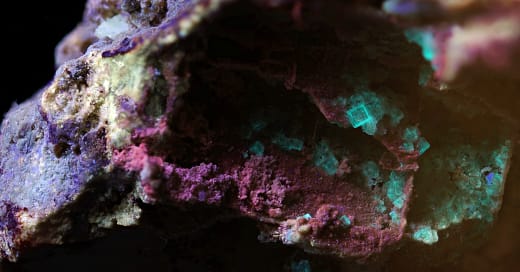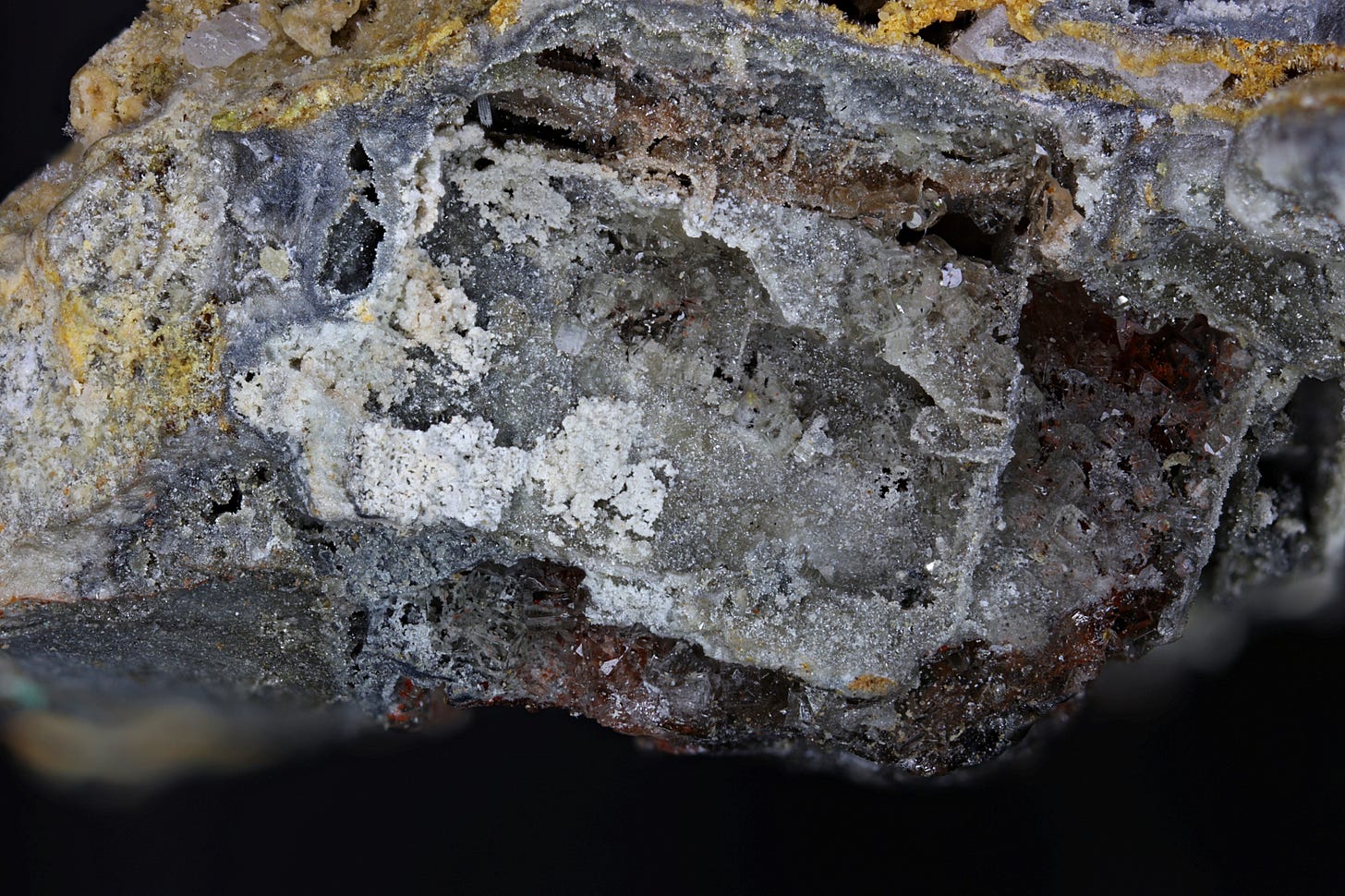Let's dive into the wonderfully glowing world of fluorescent minerals! It's a fascinating side of mineral collecting. Understanding UV light is key, so let's break it down:
UV Light: It's All About the Wavelength
Think of light as waves, like ripples in a pond. UV (Ultraviolet) light is invisible to the human eye, it's just past the violet end of the visible spectrum. But, different types of UV light have different wavelengths, which are the distance between the peaks of those "ripples." These wavelengths are measured in nanometres (nm).
For mineral collectors, there are generally three types of UV we're interested in:
1. Long Wave UV (LWUV) - The "Gentle Giant"
Wavelength: Generally around 365-400 nm.
The "Mineral Fluorescence" Longwave: We're talking specifically about 365 nm when discussing longwave UV for mineral fluorescence. This wavelength is crucial because it efficiently excites the fluorophores (the light-emitting components) in many minerals.
The "Blacklight" Zone: Yes, anything above 365 nm, particularly around 395 nm to 405 nm, is more accurately described as "blacklight" (as you'd see in party or security lights). While these lights emit UV, it's a much lower energy UV and its spectral output is far different than 365nm. This means the "blacklight" doesn't reliably excite the same fluorescence reactions in minerals, and may not produce any noticeable fluorescence in many minerals. It's primarily useful for making certain specific materials, like those used in security markings or party posters, glow.
The Issue with Overlap: Many commercially available lights marketed as "longwave" for mineral collectors unfortunately emit in that broader 365-400nm range. This means some of their light output is ineffective and it's not purely the 365nm we actually want for mineral fluorescence.
How it Affects Minerals: Many minerals will fluoresce under LWUV, producing a variety of colours. It's often the first light collectors use when starting out. It can be very effective in bringing out phosphorescence in certain minerals.
Pros: Easy to find, relatively inexpensive, and shows fluorescence in a good number of minerals. Great for general "ooh-ing" and "ahh-ing".
Cons: Some minerals respond weakly or not at all to LWUV. The fluorescence colours can sometimes be less intense than under other UV wavelengths.
2. Short Wave UV (SWUV) - The "Powerful Punch"
Wavelength: Around 254 nm.
Think Of It As: The more powerful, energetic, and shorter waves of UV. It's often described as "harsh" UV.
How It Affects Minerals: SWUV often causes much more intense fluorescence than LWUV in many minerals. It can also reveal colours not seen under LWUV. Sometimes a mineral will only fluoresce under shortwave and not longwave.
Pros: Can reveal the most dramatic fluorescence in many specimens, highlighting colours you wouldn't see otherwise.
Cons: Shortwave lights are typically more expensive than longwave, and can require higher powered bulbs. Exposure to shortwave should be kept short, as it can be harmful to eyes and skin.
3. Medium Wave UV (MWUV) - The "Hidden Gem"
Wavelength: Around 310 nm.
Think Of It As: Sitting neatly between long and short, MWUV often hits the "sweet spot" for a good number of minerals that may not be as flashy under longwave, and might not respond under shortwave.
How It Affects Minerals: Sometimes, minerals fluoresce best under MWUV. The colours can be different and sometimes even more vibrant than under LWUV or SWUV. Some minerals will fluoresce at their most brilliant colour.
Pros: It reveals hidden fluorescence that LW and SW might miss. Can have very vibrant colours in many specimens.
Cons: Good quality MWUV lamps and filters are harder to find and more expensive. Not as commonly discussed, making information a bit harder to find.
The Importance of Filters - Crucial to the Process
Here's why the right filters are essential:
Filtering out "White Light" Interference: All light sources, even those marketed as UV, emit some amount of visible light. This "white light" (or "visible light") leakage interferes with the ability to properly see the true fluorescent response of a mineral. The human eye is much more sensitive to visible light, and that washes out or dulls the often-subtle fluorescence of a mineral specimen.
How Filters Work: Proper UV lights for mineral collectors use special filters, often made from glass or other materials, that block out or drastically reduce the amount of visible light. The better-quality filters, the more they block out, and the better you'll see the actual fluorescence.
The Result: Purified Fluorescence: With a good filter, the UV light is effectively producing a much "purer" source of UV, which translates to a clearer, more intense, and more accurate representation of the mineral's fluorescence.
Beyond the Filter: In addition to filters, the quality of the diode or bulb also affects the light output of the UV light. Cheap diodes or bulbs will not provide the same wavelength of output as those that are made by high-end suppliers.
Okay, Now the Fun Part: Why Medium Wave is the BEST! (With a Little Friendly Bias)
Okay, okay... I might be a little biased, but here's why many serious fluorescent mineral collectors, myself included, fall in love with MWUV:
The Undiscovered Country: While most people start with LWUV and might progress to SWUV, MWUV is often the hidden gem. It often reveals fluorescent reactions that neither longwave or shortwave can, bringing a surprise "wow" factor that you just don't see coming.
Colour Brilliance: For many minerals that do fluoresce under multiple UV wavelengths, the colours under MWUV are sometimes simply the best. They can be incredibly vibrant, deeper, and more saturated than under the other wavelengths.
Mineral Exclusivity: It turns out many minerals that are typically very dull looking and unexciting will have some type of unique glow to them under MWUV. This helps add character and value to mineral specimens that many collectors simply overlook.
The "In-The-Know" Factor: Let's face it, using MWUV makes you feel like you're in on a secret. It's a bit more niche, and that makes the discoveries and surprises even more rewarding. This makes your collection stand out, and it's a bit more like being a real "fluorescent connoisseur."
Important Considerations:
Safety First: UV light can be harmful, particularly SWUV. Always wear UV-blocking glasses, and limit exposure to both your eyes and skin. Never point a UV light at another person or animal.
Quality Matters: For good fluorescence, invest in good quality UV lights. Cheap, weak lights will not give you the best experience. Look for quality filters and bulbs.
Experiment!: Every mineral is different. The beauty of fluorescence collecting is the constant discovery, and the need to look at all your minerals under different lights. Experimenting is a big part of the fun!
Key Takeaways:
Longwave is 365 nm for Mineral Fluorescence: The most useful longwave for mineral fluorescence is specifically around 365 nm, and anything much higher isn't ideal.
"Blacklight" is NOT Mineral Longwave: Blacklights that emit UV around 395-405 nm aren't generally useful for mineral fluorescence.
Filters are Non-Negotiable: A good UV light must have a proper filter to remove visible light, and ensure the purity of the UV light.
Be Aware of Light Specs: When buying UV lights, especially longwave, be sure the specifications actually state 365nm and also includes good filters. This is especially true of LED lights that are mass produced with very little quality control.
So there you have it! While all three wavelengths have their place, for those wanting to really get to know the full beauty of fluorescence, MWUV is often the key. It's like unlocking a secret level of mineral collecting. Enjoy the journey!
Below: Fluorite, hydrocerussite-laurionite, pyromorphite, and unknowns, in the spot where galena once was, from the Avondale Mine, Lyndhurst, Flinders Ranges, South Australia. Width of view 6mm. Medium Wave UV. All you see under shortwave is the green fluorite response, with duller versions of the various shades of pink and purple. Under longwave, you see a yellowish response from the hydrocerussite-laurionite, the pink-purple area under MW. Click on photo for a higher resolution version.
Below: Specimen under normal white light. Click on photo for a higher resolution version.






Excellent! Didn't expect to find such a good article - even for non-newbies - on this!
I have LW and SW. Short of trawling internet, it would be nice to find an affordable MW at a mineral show.
Sounds like the old radio frequencies! Perhaps next we’ll have VHF.